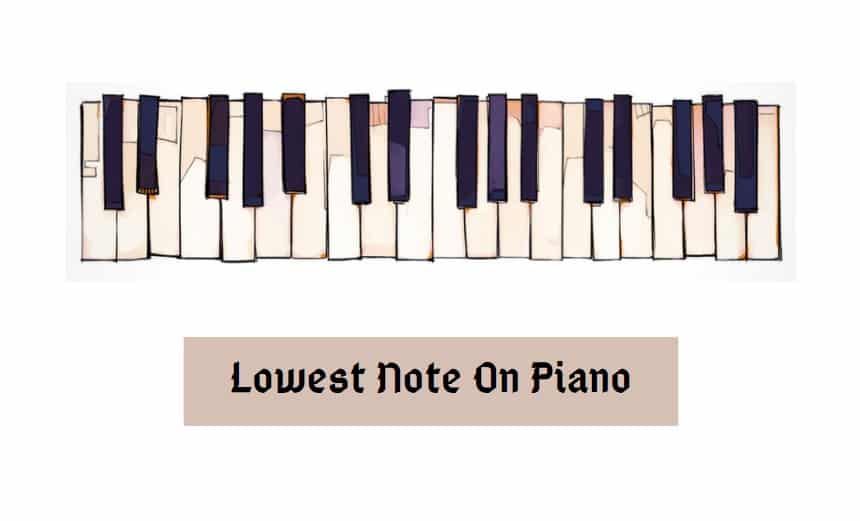
It is broadly agreed that the first pianos, as we would recognize them today, were produced around the year 1700 by an Italian entrepreneur called Mr. Bartolomeo Cristofori. This instrument would have looked more like a harpsichord with the black and white keys on the keyboard reversed. Mechanisms for striking the strings would also have been quite different to today’s pianos but Cristofori laid the foundations for the instruments we enjoy playing and listening to now.
The piano from these times did not have the range of notes that we enjoy with contemporary instruments. Instead, the Cristofori piano would have had a range of between four and five octaves with the lowest note being a ‘C’ two octaves below the middle ‘C’. (C3)
Lowest Note On Piano
As demands by composers became increasingly ambitious, the manufacturing of pianos had to keep pace. The range of pianos by the mid part of the 19th century meant that the lowest note had dropped down towards an ‘F (1)’ over three octaves below middle ‘C’. In the coming decades the lowest note of the piano continued to move further down the instrument until by the time composers like Chopin, Schumann and Liszt were writing for the piano, the lowest note would have been A0.
The full range of the instrument would have resembled the instruments we have available to us today with the complete 88 note keyboard spanning seven and a quarter octaves. This evolution of the piano’s range is well illustrated in the piano pieces over these decades. It begs the question, about the use of this extended range, do composers use the lowest note on the piano? The answer is yes, many have and many do. Not only the lowest note but also the highest notes too. The opening of the famous ‘Piano Concerto’ by Edvard Grieg is just one example where the depths of the piano’s range are played.
Brahms’s ‘Rhapsody’ in G minor (Op.79; No.2) also uses A0, as do the intense Piano Sonatas by Alexander Scriabin.
Debussy’s piano composition titled, ‘Isle Joyeuse’ has A0 as its final note. If you listen carefully to a good quality recording of this and other pieces that employ an ‘A0’, you will probably hear it being slightly unclear. It is at the far reaches of the human ear.
Another work to explore would be Olivier Messiaen’s ‘Visions de l’Amen’ which begins with this super-low pitch with great effect. These and many other compositions make excellent use of this dark tone at the very far reaches of the piano keyboard.
It would be reasonable to consider that the piano has reached its evolutionary best. Could the beloved household and concert instrument be improved? Not all instruments are created equal, and the piano manufacturer Bösendorfer decided to stretch the range of some of their pianos to include a complete chromatic fifth at the low end of the instrument.
On the Bösendorfer Imperial Grand 290, they have added notes that descend to C0. The first model of this impressive instrument (1909) was at the suggestion of composer Ferruccio Busoni who had made transcriptions of JS Bach’s formidable organ works. Busoni’s idea was that a piano with a lower range could capture the tone of the 32-foot organ pipe that plays these low notes.
Other pianos have included extra notes at the top end of the piano keyboard like the ‘Stuart & Sons’ nine octave piano, but as far as my research has discovered, the lowest note available today on pianos is the low ‘C0’. If you are thinking that you may wish to have one of these pianos, make sure you have a budget of around $225,000 and be prepared to wait for delivery.
Another point worth thinking about is the range of human hearing. For most adults who do not suffer from any kind of hearing impairment, the frequency response range is from 15Hz to 20kHz. If you were to play the low ‘C0’ on the Bösendorfer Imperial Grand piano, it would resonate with a fundamental frequency of 16Hz. You can appreciate then that these additional low notes that have been added to some contemporary pianos are at the very farthest reaches of human hearing.
If you are a piano owner, it is most likely that your lowest note, even on a concert grand, is A0. This note produces a frequency of approximately 27.5Hz, which falls nicely into the aural capacity of most human beings. The argument goes from some manufacturers of extended-range pianos, that the overall sound and resonance of the instrument is markedly improved. Given that these additional notes at either end of the piano are reaching the limits of human hearing, perhaps this is true to an extent, but that is probably for each individual to decide for themselves.
With pianos reaching lo ‘C0’ though, it seems unlikely that piano manufacturers will push these ranges much further. Also, if you, as a composer, wanted to use even lower tones, there are plenty of sample libraries available for computers that will allow you to push into the extremes of possibility.
One additional thought is when do pianos stop sounding like pianos and become something else? If composers seek to extend their pieces ever further at either end of the instrument will a manufacturer build a ten-octave piano? Even though the extended range of the Bösendorfer is not a new concept, there are not many contemporary compositions I am aware of that have made use of these extra pitches. Alongside this, I do not suppose many people actually have access to pianos with extended ranges, and it is perhaps more of a novelty than a feature for genuine practical use.

That Bösendorfer C0 must have the steam powered impeller fitted, just to save the pianist from breaking the left little finger in the effort.
A fascinating insight into gigantic pianos. What ever next?